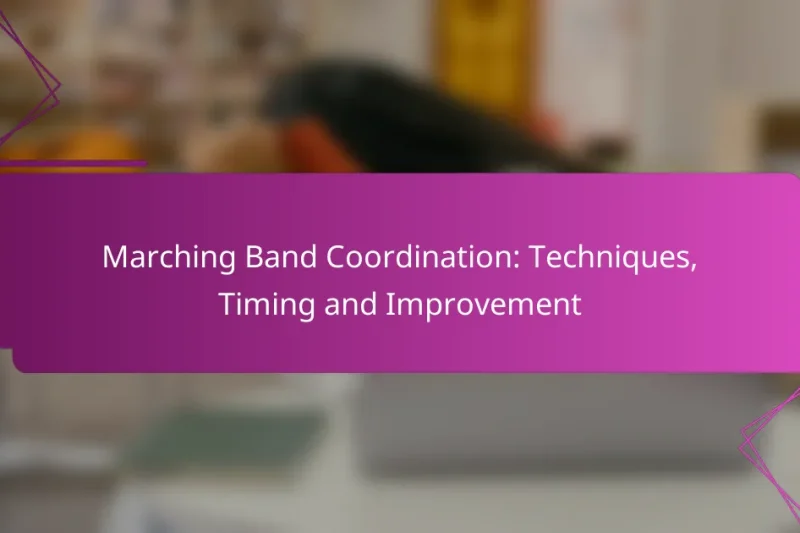Effective scheduling for high school marching bands is essential for maximizing practice time and improving performance. … Marching Band Scheduling: High School Needs, Flexibility and EffectivenessRead more
Marching Band Rehearsal Techniques
Effective marching band rehearsal techniques are essential for maximizing practice time and enhancing performance quality. By incorporating structured warm-ups, sectional rehearsals, and targeted exercises, bands can improve individual skills and foster group cohesion. Additionally, leveraging technology can streamline rehearsals and address common challenges such as time management and communication barriers.
Marching Band Engagement: Strategies, Techniques and Activities
Engaging marching band members is essential for fostering a vibrant and motivated community. By incorporating innovative … Marching Band Engagement: Strategies, Techniques and ActivitiesRead more
Marching Band Practice: Individual Focus, Group Dynamics and Balance
Marching band practice thrives on the interplay between individual focus and group dynamics. By honing personal … Marching Band Practice: Individual Focus, Group Dynamics and BalanceRead more
Marching Band Coordination: Techniques, Timing and Improvement
Marching band coordination is essential for achieving a synchronized and visually appealing performance. By focusing on … Marching Band Coordination: Techniques, Timing and ImprovementRead more
Marching Band Rehearsals: Effectiveness, Structure and Engagement
Marching band rehearsals are essential for enhancing performance quality and fostering team cohesion, and their effectiveness … Marching Band Rehearsals: Effectiveness, Structure and EngagementRead more
Marching Band Rehearsals: Technology, Engagement and Results
Marching band rehearsals can greatly benefit from the integration of technology, which enhances precision, engagement, and … Marching Band Rehearsals: Technology, Engagement and ResultsRead more
Marching Band Rehearsals: 2-Hour Structure, Efficiency and Engagement
A well-structured 2-hour marching band rehearsal is crucial for maximizing both efficiency and engagement among members. … Marching Band Rehearsals: 2-Hour Structure, Efficiency and EngagementRead more
What are effective marching band rehearsal techniques?
Effective marching band rehearsal techniques focus on maximizing practice time and improving performance quality. These methods include structured warm-ups, sectional rehearsals, visual coordination exercises, rhythmic drills, and feedback sessions, each designed to enhance specific skills and group cohesion.
Structured warm-up routines
Structured warm-up routines are essential for preparing musicians physically and mentally before rehearsal. These routines typically last 15-30 minutes and should include breathing exercises, scales, and basic marching techniques. Consistency in warm-ups helps build muscle memory and reduces the risk of injury.
Incorporating a variety of exercises can keep the warm-up engaging. For example, alternating between long tones and short bursts of sound can help develop both control and dynamics. Aim to include both individual and ensemble-focused activities to cater to different skill levels.
Sectional rehearsals
Sectional rehearsals allow smaller groups within the band to focus on specific parts of the music. These sessions can last from 30 minutes to an hour and should concentrate on challenging sections, ensuring each musician understands their role. This targeted approach fosters collaboration and improves overall performance.
Encouraging section leaders to guide these rehearsals can enhance accountability and leadership skills. It’s beneficial to schedule regular sectionals throughout the season, allowing for continuous improvement and adaptation to new music or changes in the ensemble.
Visual coordination exercises
Visual coordination exercises help musicians synchronize their movements while playing. These drills often involve practicing formations and transitions without instruments, focusing on body alignment and spacing. Regular practice of these exercises can lead to a more polished visual performance during shows.
Incorporating mirror drills, where musicians face each other to observe and correct posture, can be particularly effective. Aim for 10-15 minutes of visual coordination practice in each rehearsal to reinforce these skills consistently.
Rhythmic drills
Rhythmic drills are crucial for developing timing and ensemble cohesion. These exercises can include clapping patterns, playing to a metronome, or using percussion instruments to establish a strong beat. Regular rhythmic practice helps musicians stay in sync during performances.
Consider incorporating a variety of tempos and styles in rhythmic drills to challenge musicians and keep the practice dynamic. Short, focused sessions of 5-10 minutes can be effective, allowing for quick adjustments and immediate feedback.
Feedback sessions
Feedback sessions provide an opportunity for musicians to receive constructive criticism and celebrate successes. These sessions can occur at the end of rehearsals and should focus on both individual and group performance. Encouraging open dialogue fosters a supportive environment for growth.
Utilizing video recordings of rehearsals can enhance feedback sessions, allowing musicians to visually assess their performance. Aim to dedicate 10-15 minutes for feedback after each rehearsal, ensuring that it is specific, actionable, and balanced between strengths and areas for improvement.
How can technology enhance marching band rehearsals?
Technology can significantly enhance marching band rehearsals by providing tools that improve precision, coordination, and overall performance quality. By integrating devices and applications, bands can streamline practice sessions and focus on key areas for improvement.
Use of metronomes and tuners
Metronomes and tuners are essential tools for maintaining tempo and pitch accuracy during rehearsals. A digital metronome can provide visual and auditory cues, helping musicians stay in sync, while tuners ensure that instruments are properly pitched, which is crucial for ensemble harmony.
When using these tools, consider setting the metronome to various tempos to challenge the band and improve their adaptability. Regularly checking tuning before practice can save time and enhance the quality of the performance.
Video analysis tools
Video analysis tools allow bands to record rehearsals and review performances for immediate feedback. By watching their movements and formations, musicians can identify areas for improvement, such as timing issues or alignment problems.
Utilizing software that provides slow-motion playback or frame-by-frame analysis can be particularly beneficial. Encourage band members to watch specific sections of their performance to gain insights and make necessary adjustments before the next rehearsal.
Mobile apps for scheduling
Mobile apps for scheduling can streamline communication and organization within a marching band. These apps allow directors to share rehearsal times, locations, and any changes instantly, ensuring that all members are informed and prepared.
When selecting a scheduling app, look for features like calendar integration, push notifications, and attendance tracking. This can help reduce missed practices and improve overall participation, which is vital for a cohesive performance.
What are common challenges in marching band rehearsals?
Marching band rehearsals often face several challenges that can hinder progress and performance quality. Common issues include time management problems, communication barriers, and weather-related disruptions, each requiring specific strategies to overcome.
Time management issues
Effective time management is crucial in marching band rehearsals, as limited practice time can impact overall performance. Scheduling conflicts, inadequate planning, and distractions can lead to inefficient use of rehearsal time.
To improve time management, establish a clear agenda for each rehearsal and stick to it. Use timers to allocate specific durations for warm-ups, drills, and music practice, ensuring that each segment receives adequate attention.
Communication barriers
Communication barriers can arise from varying skill levels, different learning styles, or even physical distance during outdoor rehearsals. These barriers can lead to misunderstandings and hinder the learning process.
To enhance communication, consider using visual aids, such as charts or diagrams, and encourage open dialogue among members. Regular check-ins and feedback sessions can also help clarify expectations and foster a collaborative environment.
Weather-related disruptions
Weather can significantly impact marching band rehearsals, with rain, extreme heat, or cold temperatures affecting both attendance and performance quality. Planning for these disruptions is essential to maintain consistent practice.
Have a backup plan for indoor rehearsals when weather conditions are unfavorable. Additionally, monitor forecasts and adjust schedules proactively to avoid cancellations. Ensure that members are dressed appropriately for the weather to maintain comfort and focus during practice.
What criteria should be considered for rehearsal planning?
Effective rehearsal planning requires careful consideration of goals, skill levels, and available resources. These criteria ensure that rehearsals are productive and tailored to the needs of the marching band.
Rehearsal goals and objectives
Establishing clear rehearsal goals and objectives is essential for guiding the band’s progress. Goals might include mastering specific pieces, improving synchronization, or preparing for an upcoming performance. Setting measurable objectives helps track progress and keeps members motivated.
For example, a goal could be to enhance the performance of a particular song by the end of the month, with objectives such as achieving a specific tempo or improving dynamics. Regularly revisiting these goals can help maintain focus and accountability.
Band member skill levels
Understanding the varying skill levels of band members is crucial for effective rehearsal planning. This knowledge allows the director to tailor exercises and parts to suit different abilities, ensuring that all members are engaged and challenged appropriately.
For instance, advanced players might tackle more complex pieces while beginners focus on fundamental techniques. Regular assessments can help identify skill gaps and inform decisions about grouping members for specific exercises or sections.
Available resources and equipment
Assessing available resources and equipment is vital for successful rehearsals. This includes instruments, uniforms, and any necessary technology, such as sound systems or metronomes. Ensuring that all members have access to the required resources can significantly impact rehearsal effectiveness.
Consider creating a checklist of essential equipment to verify availability before each rehearsal. Additionally, if budget constraints exist, prioritize resources that directly enhance the learning experience, such as quality instruments or instructional materials.
What are the benefits of outdoor versus indoor rehearsals?
Outdoor and indoor rehearsals each offer unique advantages that can enhance a marching band’s practice sessions. Choosing the right environment depends on factors such as weather, space, and the specific goals of the rehearsal.
Outdoor rehearsal advantages
Outdoor rehearsals provide ample space for movement and formations, allowing bands to practice marching techniques effectively. The natural environment can enhance sound projection, helping musicians hear each other better and adjust their playing accordingly.
Additionally, outdoor settings can simulate performance conditions, preparing the band for events held in similar environments. Weather permitting, outdoor rehearsals can also foster team bonding through shared experiences in a relaxed atmosphere.
Indoor rehearsal benefits
Indoor rehearsals offer a controlled environment, free from weather-related interruptions. This stability allows for consistent practice conditions, which can be crucial for focusing on specific musical elements or intricate choreography without external distractions.
Moreover, indoor spaces often have better acoustics, allowing musicians to hear the nuances of their sound more clearly. This can be particularly beneficial for fine-tuning dynamics and blending within the ensemble.
How can marching bands improve performance quality?
Marching bands can enhance their performance quality through consistent practice, structured feedback, and effective instruction. By focusing on these areas, bands can identify weaknesses, refine skills, and elevate their overall sound and visual presentation.
Regular feedback and assessments
Implementing regular feedback sessions and assessments is crucial for improving performance quality in marching bands. These evaluations can take place after rehearsals or during competitions, allowing members to receive constructive criticism on their playing, marching technique, and overall cohesion.
Consider using a mix of peer reviews and instructor assessments to provide diverse perspectives. Establish a routine where each member receives feedback at least once a month, focusing on specific areas for improvement. This approach fosters accountability and encourages continuous growth.
Incorporating guest instructors
Bringing in guest instructors can significantly enhance the learning experience for marching band members. These professionals often bring fresh perspectives, specialized skills, and new techniques that can help elevate the band’s performance quality.
When selecting guest instructors, look for individuals with experience in marching band competitions or those who have a strong background in music education. Schedule workshops or masterclasses that focus on specific areas such as drill design, music interpretation, or visual performance. This not only enriches the band’s skill set but also motivates members by exposing them to different teaching styles and expertise.






